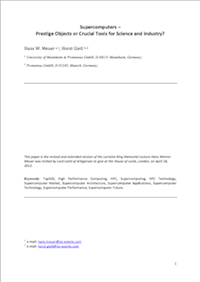
This paper is intended for people interested in High Performance Computing (HPC) in general, in the performance development of HPC systems for science and industry from the beginning in the 1970s and, above all, in HPC applications in the past, today and tomorrow. Readers do not need to be supercomputer experts.
In wiseGEEK [1], a supercomputer is defined as follows: A supercomputer is a computer which performs at a rate of speed which is far above that of other computers. Given the constantly changing world of computing, it should come as no surprise to learn that most supercomputers bear their superlative titles for a few years, at best. Computer programmers are fond of saying that today's supercomputer will become tomorrow's workstation.
To give an example: In 1986, the most powerful supercomputer in the world was the famous Cray2, available for roughly US$ 22 million at that time. Last year, Apple released their iPad2 tablet computer, the performance of which is two-thirds of the Cray2’s, but the price of which is only US$ 500. This means that, in 25 years, the price has gone down by a factor of 44,000, so today’s supercomputer is tomorrow’s (tablet) computer.
The father of supercomputers is Seymour Cray, former chief designer at Control Data Corporation (CDC). In the 1960s, he had already developed powerful mainframe computers like the CDC 6600/7600. In 1972, Seymour Cray left CDC and founded his own (supercomputer) company, Cray Research. The first product was the Cray1, the very first supercomputer in the world; the first system was delivered to Los Alamos National Laboratory in the U.S.
In this paper, we will first discuss the TOP500 supercomputer project, which was launched at the University of Mannheim, Germany, in 1993; it is the only project in the world that has been successfully tracking and evaluating the supercomputer market for 20 years. Two TOP500 lists are published per year, one at the International Supercomputing Conference in Germany in June and one at the SC Conference in the U.S. in November. This paper will focus on the results of the 39th TOP500 list published in June 2012. In chapter 3, we will present six examples of HPC applications in science and industry. After looking at new alternative performance metrics, we will discuss briefly the future of supercomputing at the end of this paper.
All information that you supply is protected by our privacy policy. By submitting your information you agree to our Terms of Use.
* All fields required.



